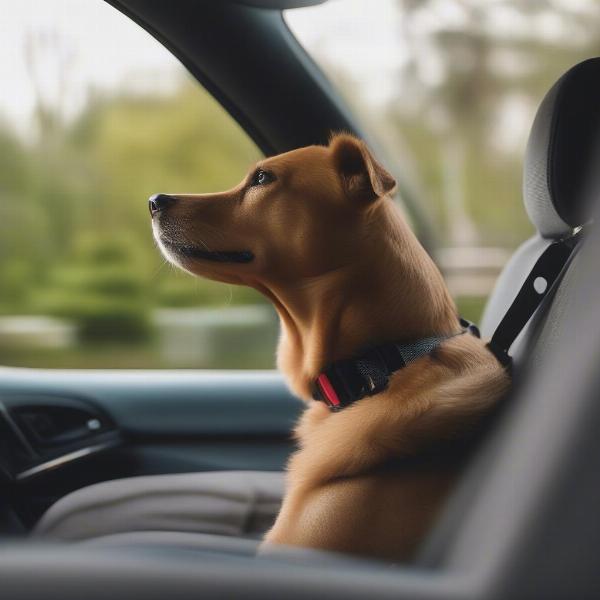Car dog restraints are essential for the safety and well-being of both your furry friend and everyone else in the vehicle. Unrestrained dogs can become dangerous projectiles in an accident, posing a significant risk to themselves and passengers. Beyond safety, using a proper car dog restraint can also reduce driver distraction, ensuring a more focused and controlled driving experience. This article will delve into the importance of car dog restraints, the various types available, and how to choose the right one for your canine companion.
Why Use a Car Dog Restraint?
Beyond the obvious safety benefits, using a car dog restraint can significantly reduce driver distractions. A loose dog roaming around the car can easily distract the driver, leading to potential accidents. A properly restrained dog is less likely to interfere with driving, allowing you to focus on the road and arrive safely at your destination. Furthermore, restraints can minimize car sickness in dogs by providing a stable and secure environment. This is particularly important for puppies or dogs prone to motion sickness.
Types of Car Dog Restraints
There’s a wide variety of car dog restraints on the market, each designed for specific needs and dog sizes. Choosing the right type can depend on factors like your dog’s breed, size, temperament, and the type of vehicle you own.
Dog Seat Belts
Similar to human seat belts, these restraints attach to your car’s existing seat belt system. They typically consist of a harness that your dog wears, which then connects to the seat belt buckle. Dog seat belts are a versatile option, suitable for various dog sizes.
Dog Crates and Carriers
Crates and carriers offer a more enclosed and secure environment, particularly suitable for anxious dogs or puppies still learning car etiquette. They provide a safe haven and can minimize motion sickness. Choose a crate or carrier that is appropriately sized for your dog, allowing them to stand, sit, and lie down comfortably. Remember to secure the crate or carrier properly within the vehicle to prevent it from shifting during travel.
Dog Car Seats
Designed for smaller dogs, car seats elevate them to window level, offering a better view and reducing anxiety. They usually attach to the car seat using the seat belt and often feature a tether to secure your dog.
Dog Barriers
These barriers, typically made of metal or mesh, are installed behind the front seats, preventing your dog from accessing the front of the car. They’re a good option if you have a larger dog who needs more space in the back but should not be roaming freely.
Choosing the Right Restraint for Your Dog
Selecting the correct car dog restraint involves considering your dog’s size, breed, and temperament. A small dog might be comfortable in a car seat, while a larger breed might require a more robust harness and seat belt system. car restraint for dogs For anxious dogs, a crate or carrier can provide a sense of security. It’s also crucial to ensure the restraint is compatible with your vehicle’s seat belt system and properly installed.
Tips for Safe Travels with Your Dog
Beyond choosing the right restraint, here are some additional tips for ensuring safe and comfortable car journeys for your furry companion:
- Introduce the restraint gradually: Allow your dog to get used to the restraint at home before using it in the car.
- Never leave your dog unattended in a hot car: Even on mildly warm days, the temperature inside a car can rise rapidly, leading to heatstroke.
- Pack essentials: Bring water, food, bowls, and any necessary medications for your dog.
- Take regular breaks: Stop every few hours to allow your dog to stretch their legs and relieve themselves.
Conclusion
Using a car dog restraint is a crucial aspect of responsible pet ownership. It not only ensures the safety of your dog and passengers but also contributes to a more focused and comfortable driving experience. By choosing the appropriate restraint and following these safety tips, you can make car travel a pleasant experience for both you and your canine companion. dog restraint car Remember, a restrained dog is a safe and happy dog.
FAQ
- What is the safest way to transport a dog in a car? Using a crash-tested crate or carrier is generally considered the safest option.
- Are dog seat belts effective? Yes, dog seat belts can be effective when used correctly and with a properly fitted harness.
- Can I use a regular human seat belt for my dog? No, human seat belts are not designed for dogs and can be dangerous.
- What should I do if my dog gets car sick? Consult your veterinarian for advice and potential medications.
- How can I get my dog used to a car restraint? Introduce the restraint gradually at home with positive reinforcement.
 Happy Dog Enjoying Car Ride in Restraint
Happy Dog Enjoying Car Ride in Restraint
ILM Dog is a leading international website dedicated to providing expert advice and resources on all aspects of dog care and wellbeing. We cover everything from breed selection and health care to training, nutrition, grooming, and much more. Whether you’re a first-time dog owner or a seasoned expert, our aim is to empower you with the knowledge and tools to provide the best possible care for your furry friend. dog pod For personalized guidance and expert advice, contact us at [email protected] or call us at +44 20-3965-8624. ILM Dog is your trusted partner in ensuring a happy and healthy life for your beloved companion.